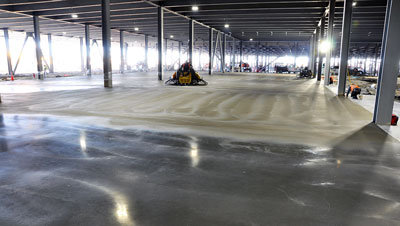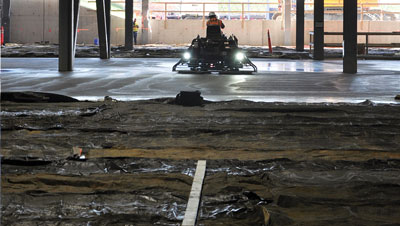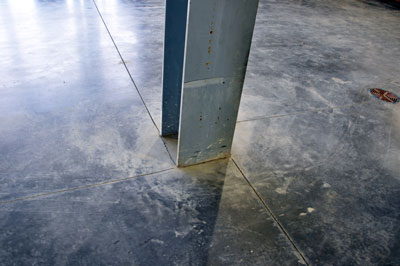Authorized installer Wayne Brothers proves MEGASLAB tendencies to low carbon metrics, high load-bearing potential, plus concrete schedule and jointing optimization


The MEGASLAB specification equates to a 70 percent reduction in the amount of jointing that a conventional 9-in. thick alternative would require. The darker, glass-like section shown here has received a final trowel pass and is ready for MEGASpray. Following that application, Wayne Brothers crews place blankets as weather conditions warrant for MEGASLAB sections curing to 28-day 5,000-psi design strength targets.
Five years out from an inaugural field placement, Georgia-based MEGASLAB has extended the value proposition of its namesake concrete structure from abrasion resistance, high load capacity and minimal drying shrinkage characteristics to markedly lower carbon metrics when measured against conventional slabs on grade. Formulated and finished with proprietary mix designs, materials and methods, MEGASLAB is engineered to carry heavy industrial or vehicular traffic at thicknesses typically one-third to one-half of plain or reinforced concrete alternatives.
In a current manufacturing facility contract with square footage in the seven-digit range, Wayne Brothers Companies is placing 6-in. thick MEGASLAB sections free of steel reinforcement, and saw cutting joints only on steel H or W column lines. Davison, N.C.-based Wayne Brothers is a key slab and industrial pavements player across the Southeast and an authorized MEGASLAB installer. It the secured the manufacturing facility’s performance slab on grade specification as an alternative to an initial 9-in. thick, reinforced design.
Wayne Brothers promoted the specification’s carbon reduction potential on three tangible factors: One-third less concrete, a 90-plus percent reduction in reinforcing steel requirements, and the ability to standardize mix designs around a binder of Type IL portland limestone with Class F fly ash at 20 percent. “The MEGASLAB solution and blended cement positioned us to report a 45 percent embodied carbon reduction versus a concrete and slab specification more typical of this type of facility,” affirms Executive Vice President of Business Management Chad Hensley, P.E. The current project extends Wayne Brothers’ growing roster of MEGASLAB installations, he adds, led by a contract involving five miles of service roads at a Kentucky plate mill for Charlotte, N.C.-based Nucor Corp., North American steel market leader.


MEGASLAB can be engineered for broad (> 100 feet) saw cut or armored joint spacing as owners require. In their current installation, Wayne Brothers crews have primarily cut joints along column lines of large bays. Their tool of choice is the Soff-Cut saw which, in tandem with the Somero laser screed, has revolutionized industrial concrete slab practice since its early 1990s rollout.
PROVEN PRACTICE
The materials, technology and practice behind the MEGASLAB brand were commercialized in 2018-2019. Early projects exhibiting extended service life potential included a Caterpillar dealer yard pavement routinely subjected to bulldozer traffic and steel track grind. Suited to slab on grade or concrete on metal deck conditions, the system combines a base mix design tailored around local aggregates and cementitious materials, plus a proprietary blend of fibers, water reducer, viscosity modifier and other admixtures introduced at a dosing station separate from the ready mixed concrete batch plant. The extra materials require five minutes of drum revolutions beyond the main load. Ahead of pours, MEGASLAB stipulates laser-guided ground leveling to a 1/4-in. tolerance—ensuring a very uniform structure and accurate concrete volume estimates.
Standard practice with 6-in. target slump mixes entails the Somero laser screed—a fixture for Wayne Brothers and peers in industrial slabs on grade—and ride-on trowel passes. The MEGASLAB mix design and placing methodology limit bleed water and curtail coarse aggregate settling, thereby imparting optimal flexural strength and contributing to lower drying shrinkage compared to a standard, reinforced concrete slab. A dearth of bleed water amplifies the effect of a durable and resilient finish, while application of MEGASpray—formulated to work with other system components toward a more dense, abrasion resistant slab—is the final step. Minimal drying shrinkage is confirmed in ASTM E1155-20, Standard Test Method for Determining FF Floor Flatness and FL Floor Levelness Numbers measurements taken early on and months after MEGASLAB placements.

“Surface wise, our system is closer to quartz than the rigid sponge of a typical concrete slab,” explains MEGASLAB principal and developer Jason Adams. “We are delivering a slab on grade solution with structural and environmental benefit. Better engineering. Less material.”
He brought the brand from concept to the field with the assistance of Sylvester Schmidt, a veteran of Heidelberg Materials cement and concrete operations on both sides of the Atlantic, plus (pre-Cemex) RMC Industries. More recently, University of Oklahoma Professor of Civil Engineering Tyler Ley, widely recognized for his Super Air Meter quality control device and concrete practice advocacy, has contributed to MEGASLAB mix design optimization, including binder and aggregate material review.